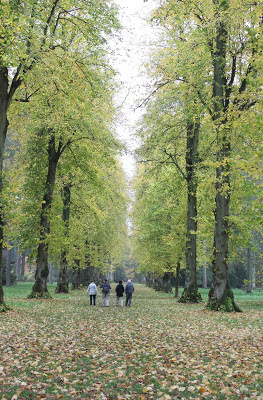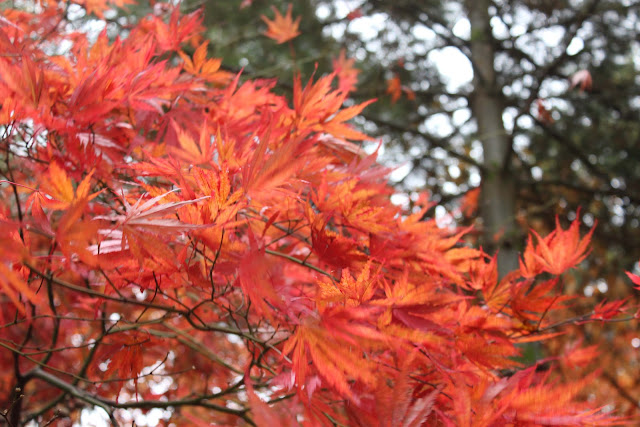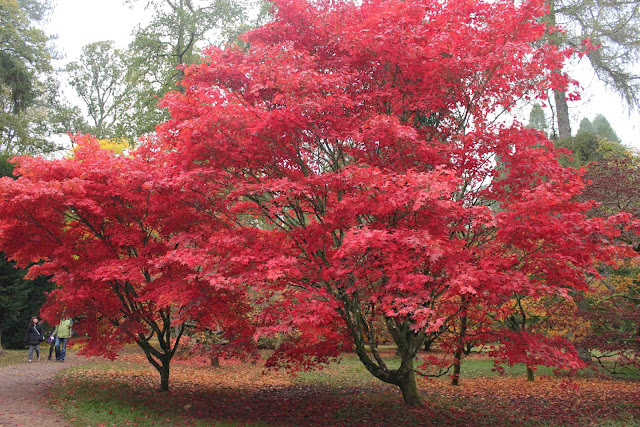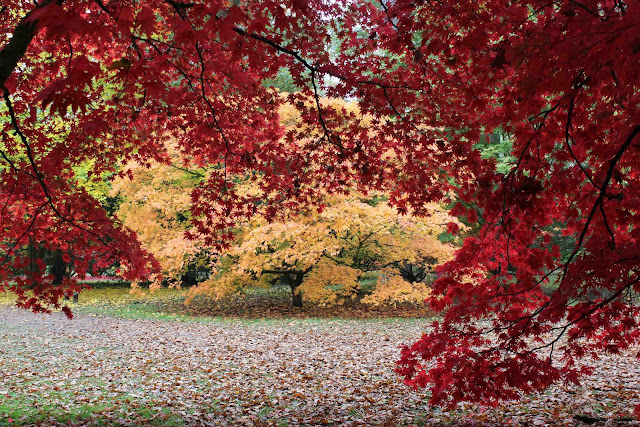With apologies to Dylan Thomas for mangling his fine poem, but these words whispered themselves in my ear relentlessly as I explored Westonbirt Aboretum earlier this week.
Autumn is so much more than a muddy slide into winter. Given half a chance, it has plenty to say for itself before winter finally clamps its icy hand around the year’s scrawny throat, and Westonbirt gives its top stars a stage to perform on. Birches, limes, and especially the maples sing before they succumb, belting out bold and bright in a last hurrah of vermillion and gold. And meanwhile every ripple of air brings another cascade of leaves fluttering down, forming quiet, overlapping pools of colour on the grass beneath.
 I’d like to pretend to you that I wandered around in a poetic fog of blissful wonder in the face of all this beauty. But, as a good friend and English literature graduate once explained, somewhat wistfully, he can no longer simply read a book for pleasure. He cannot help but consider the structure, the context, the characterisation, examine the style of writing and identify its place or otherwise in the canon. Understanding has brought him knowledge, but cost him the simple, child-like pleasure of escape.
I’d like to pretend to you that I wandered around in a poetic fog of blissful wonder in the face of all this beauty. But, as a good friend and English literature graduate once explained, somewhat wistfully, he can no longer simply read a book for pleasure. He cannot help but consider the structure, the context, the characterisation, examine the style of writing and identify its place or otherwise in the canon. Understanding has brought him knowledge, but cost him the simple, child-like pleasure of escape.
It’s a futile task of course. The picture above was taken standing amid the branches of a stunning Acer palmatum amoenum. You get a sense of it, but what I could not capture was the colour of the light under the tree. How the light outside was a cool lemony-grey, but inside the canopy I was encased in a warm amber glow. Neither could I capture the soft rustle of a hundred thousand tissue paper leaves, or the veinous map of its many branches reaching out low and wide around me.
A slight mist hung in the mild air all day, lending an ethereal quality to the light. Distant views were shrouded and with no sun to orient myself to, the afternoon took an air of a mystery tour, guided by the tempting turn of a path rather than by clear sightings of colour in the distance. So I can’t be sure I saw the best of it, but what I did see was fabulous.
Westonbirt is big enough to get quite lost. I am a quick walker – a strider – despite stocky little legs and a 5’4″ frame. I walked non-stop for four hours, apart from pauses to take pictures, never once re-covered my tracks and yet, according to the guide map, managed to cover less than half the area. Most routes are solid underfoot, but if you want to wander off-piste and kick a few leaves about, there’s plenty of scope for that. If you go, allow an entire day.
 I’d like to pretend to you that I wandered around in a poetic fog of blissful wonder in the face of all this beauty. But, as a good friend and English literature graduate once explained, somewhat wistfully, he can no longer simply read a book for pleasure. He cannot help but consider the structure, the context, the characterisation, examine the style of writing and identify its place or otherwise in the canon. Understanding has brought him knowledge, but cost him the simple, child-like pleasure of escape.
I’d like to pretend to you that I wandered around in a poetic fog of blissful wonder in the face of all this beauty. But, as a good friend and English literature graduate once explained, somewhat wistfully, he can no longer simply read a book for pleasure. He cannot help but consider the structure, the context, the characterisation, examine the style of writing and identify its place or otherwise in the canon. Understanding has brought him knowledge, but cost him the simple, child-like pleasure of escape.
It’s a bit like that for me now with gardens and plants. I admire the plant in its setting for a moment or two, but then I must know what the plant it is and where it came from. I will peer closely at the bark texture, the way the branches emerge from the trunk, the leaf shape, the overall form of it. I want to know how old it is, gauge its growth rate and maturity.
Above all, I must find some signifying feature which will mean that if I see its like again elsewhere a flash of recognition might bring back a memory, perhaps even a name. I cannot now visit gardens other than as a plantswoman and elementary botanist. If I’ve lost something in that, it’s a small loss.
 |
Only my desire to take a decent photograph saves me from being a complete plant geek. On seeing a fine tree, the first task is to look for a label, thankfully almost always present in a well run botanic garden like this. Then take a closer look at the plant, trying to store a memory of it for the future. Finally, having made its acquaintance, I’ll seek a way to capture the essence of it. I want something more than a snap, a photo-portrait perhaps.
It’s a futile task of course. The picture above was taken standing amid the branches of a stunning Acer palmatum amoenum. You get a sense of it, but what I could not capture was the colour of the light under the tree. How the light outside was a cool lemony-grey, but inside the canopy I was encased in a warm amber glow. Neither could I capture the soft rustle of a hundred thousand tissue paper leaves, or the veinous map of its many branches reaching out low and wide around me.
There is nothing that can replace seeing and experiencing something first hand to sear it into memory. Last week an interviewer asked Felix Baumgartner why he couldn’t have just watched a video of earth from space instead of seeing it for himself before diving to earth. I presume he had run out of sensible questions to ask in the allotted time.
 |
| Acer palmatum ‘Matsumurae’ |
So I shall spare you the botany and leave you to enjoy the pictures. Except to say that despite careful study I am still unable to reliably distinguish Acer palmatum atropurpureum from A. p. amoenum (which, unhelpfully, simply means beautiful), or even A. p. ‘Osakazuki’ of which I own two lovely, but quite different specimens. I can now, however, spot Acer palmatum ‘Matsumurae’ at a distance. Each leaflet tapers endlessly to the slenderest of points, and the whole tree shimmers in a blaze of vermilion. Ane yes, I know much of the photo of it above is out of focus. It was like trying to focus on a flame in a gale.
By way of a postscript, while I was away I left my van at the garage because none of the dashboard dials were working. It turned out it needed a new set of clocks, the circuit board at the back having blown up. Like any good rural garage who are used to keeping vehicles on the road long after others would have scrapped them, Kennedy’s in Dutton fixed it by sourcing and fitting a replacement set of clocks from a breakers (incidentally for half the cost of a minor service on a new car). I picked it up today to find that the mileometer now shows 142,863 miles, compared to about 90,000 on the old one. Apart from being pleased that it all works now, I have the odd sensation of driving a van that has had an organ transplant, as if one that died at the ripe old age of 142,000 and lay interred and unloved has been lifted from the grave and given a new life in my care.
If only we humans had such regenerative capabilities. Our 80 year or so lifespan, if we are lucky enough to live so long, is but a fraction of the time it takes to know anything much about anything. Especially about trees.



6 Responses to “Blaze, blaze against the dying of the light…”
Lovely photos, especially the one from 'inside' the acer, showing the best things about autumn- the quality of light & the beautiful leaf colours.
Lovely pictures from a wonderful arboretum. What you said about being a botanist sometimes getting between you and the plants, I often feel that about the camera too. I can be so busy taking shots, not missing anything, that I don't take the time to just look with my own eyes, to just be there.
Your photos are grand, but it is your words that grab me and won't let go.
Thank you Ricki. You've made my day…
What a lovely and romantic scene of tress… I really love your photos..
Buy Plants Online
Those are glorious photos, Sue, even if you're not completely satisfied with them. I love the fourth and the last especially – they look like impressionist paintings.
It's ages since I went to Westonbirt – you make me want to go back soon.